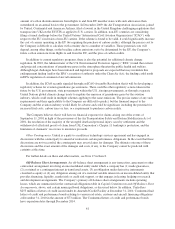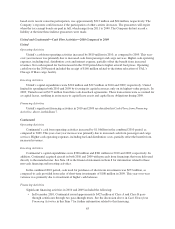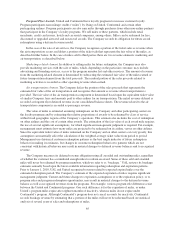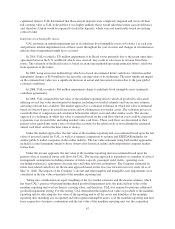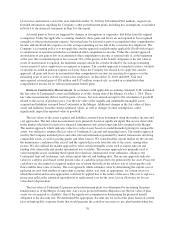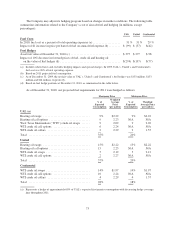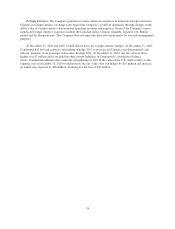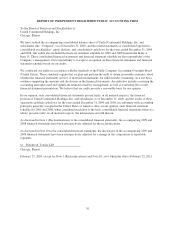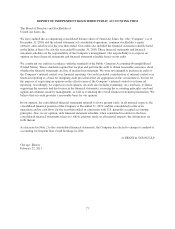United Airlines 2010 Annual Report Download - page 70
Download and view the complete annual report
Please find page 70 of the 2010 United Airlines annual report below. You can navigate through the pages in the report by either clicking on the pages listed below, or by using the keyword search tool below to find specific information within the annual report.price. As a result of this testing, UAL determined that goodwill was completely impaired and therefore recorded
an impairment charge to write-off the full value of goodwill.
Accounting for Long-Lived Assets. The net book value of operating property and equipment for UAL was
$16.9 billion and $9.8 billion at December 31, 2010 and 2009, respectively. The assets’ recorded value is
impacted by a number of accounting policy elections, including the estimation of useful lives and residual values
and, when necessary, the recognition of asset impairment charges.
The Company records assets acquired, including aircraft, at acquisition cost. Depreciable life is determined
through economic analysis, such as reviewing existing fleet plans, obtaining appraisals and comparing estimated
lives to other airlines that operate similar fleets. Older generation aircraft are assigned lives that are generally
consistent with the experience of United and Continental and the practice of other airlines. As aircraft technology
has improved, useful life has increased and the Company has generally estimated the lives of those aircraft to be
30 years. Residual values are estimated based on historical experience with regard to the sale of both aircraft and
spare parts and are established in conjunction with the estimated useful lives of the related fleets. Residual values
are based on current dollars when the aircraft are acquired and typically reflect asset values that have not reached
the end of their physical life. Both depreciable lives and residual values are revised periodically to recognize
changes in the Company’s fleet plan and other relevant information. A one year increase in the average
depreciable life of UAL’s flight equipment would reduce annual depreciation expense on flight equipment by
approximately $36 million.
Benefit Accounting. United’s obligations with respect to defined benefit pension plans were substantially
eliminated in 2006 as most of the United defined benefit plans were assumed by the PBGC as part of UAL
Corporation’s emergence from Chapter 11 bankruptcy protection. UAL’s pension obligations increased
significantly in 2010 due to UAL’s assumption of Continental obligations in the Merger. Under applicable
accounting guidance, pension expense is recognized on an accrual basis over employees’ approximate service
periods. UAL only began recognizing the impact of Continental’s plans in its financial statements beginning on
October 1, 2010.
UAL’s plans’ under-funded status was $1.5 billion at December 31, 2010, of which $1.4 billion is attributed
to Continental’s plans. Funding requirements for tax-qualified defined benefit pension plans are determined by
government regulations. We estimate that our minimum funding requirements for the Continental plans during
calendar year 2011 is approximately $126 million. The fair value of the plans’ assets was $1.9 billion at
December 31, 2010, of which $1.7 billion is attributed to assets of Continental’s plans.
The following discussion relates only to the Continental plans, as the United plans are not significant to
UAL’s total obligations.
When calculating pension expense for 2011, Continental assumed that its plans’ assets would generate a
long-term rate of return of 7.75%. The expected long-term rate of return assumption was developed based on
historical experience and input from the trustee managing the plans’ assets. The expected long-term rate of return
on plan assets is based on a target allocation of assets, which is based on a goal of earning the highest rate of
return while maintaining risk at acceptable levels. Our projected long-term rate of return is slightly higher than
some market indices due to the active management of our plans’ assets, and is supported by the historical returns
on our plans’ assets. The plans strive to have assets sufficiently diversified so that adverse or unexpected results
from one security class will not have an unduly detrimental impact on the entire portfolio. We regularly review
actual asset allocation and the pension plans’ investments are periodically rebalanced to the targeted allocation
when considered appropriate.
The defined benefit pension plans’ assets consist primarily of equity and fixed-income securities held
through common collective trusts. Equity securities include investments in large-cap and small-cap
companies. Fixed-income securities include corporate bonds of companies in diversified industries and asset and
mortgage-backed securities. Investments in equity securities and fixed-income securities are commingled funds
valued at the unit of participation value of shares held by the plans’ trusts. The private equity funds invest
primarily in common stock of companies in diversified industries and in buyout, venture capital and special
68





